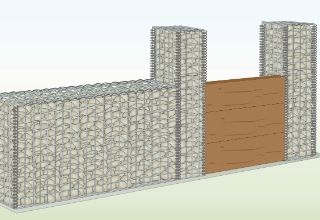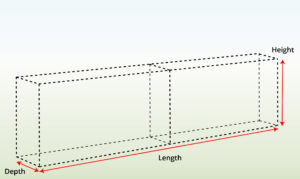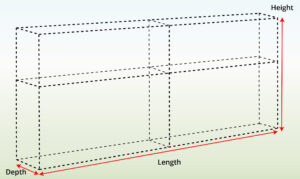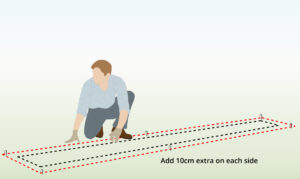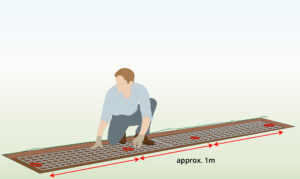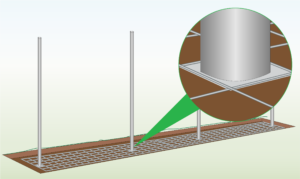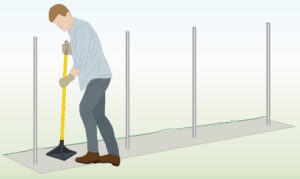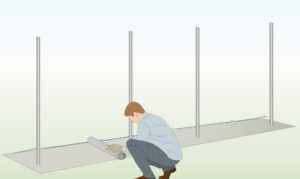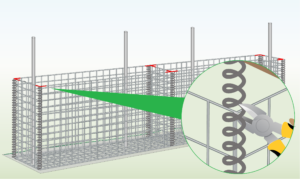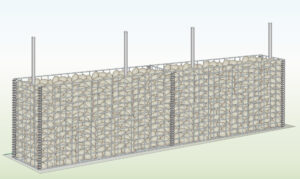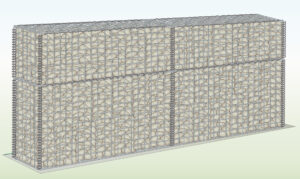Gabion Fence Installation
Below you will find a step by step guide on gabion fence installation.

- Experience Required: Medium
- Tools Required: Protective gloves, String, Pegs, Shovel, Spirit level, Tape measure, Plate compactor
- Materials Required: 4mm or 5mm Gabion baskets, Stone, Helicals, Tying wire or Cable ties, Type 1 gravel, Geotextile, Supporting posts, Concrete
Step 1) Measure Area & Plan
- Begin by measuring your space: how long it is, how much space you have from front to back, and how high you want your diy gabion fence to be.
- This will help you figure out how many baskets you’ll need.
- Also, remember to calculate how much stone you’ll need.
Step 2) Plan for Second Layer
-
For a taller fence than 1m, think about adding another layer of baskets in your plan.
Step 3) Mark the Location
- Mark the fence line with a string and pegs, allowing an extra 10 cm on each side for better alignment and stability.
- The string will ensure everything is straight.
Step 4) Prep the Foundation
- Use a shovel to dig a solid base, then level the ground and fill any gaps.
- Ensuring the base is level is crucial for stability.
Step 5) Mark Support Post Location
- Remove the lid panels from the baskets and use them to mark the position of the support posts.
- Plan to place each post inside the basket, fitting them through a mesh hole, and space them about 1 meter apart.
Step 6) Add Supports
- Dig the posts to a depth of about one-third of the height of the gabion fencing.
- Secure the support posts using concrete.
- Note: Make sure the posts are sized to fit inside a mesh hole – otherwise, you’ll need to cut the wires to accommodate them.
Step 7) Check Support Post Location
- Verify the post locations using the same lid panels while the concrete sets.
- Adjust them as needed to ensure they are in the correct positions.
- Use a spirit level to make sure the posts are straight.
Step 8) Add Basecourse
-
Add a layer of Type 1 gravel:
- For a 1m high fence, use 10cm of basecourse.
- For a 2m high fence, use 20cm of basecourse.
- For a 3m high fence or taller, use 30cm of basecourse.
Step 9) Compact Basecourse
- Compact the basecourse thoroughly for stability using either a plate compactor or a spade.
- Then, use a spirit level to check and adjust for straightness.
Step 10) Add Geotextile
- To prevent soil erosion and enable drainage, line the bottom of the structure with geotextile fabric.
- Cut holes in the fabric for the posts, then position it properly over the basecourse.
Step 11) Pre-Assemble Baskets without Lids
- Fold up and secure the vertical corners of each gabion with two cable ties: one at the top and one at the bottom of each corner.
Step 12) Position Around Support Posts
- While positioning the baskets, thread the support posts through the mesh holes in the pre-determined spots.
- Ensure the adjoining corners are pushed as close together as possible.
Step 13) Attach Baskets Together
- To prevent any movement, secure the adjoining corners of the baskets with a helical.
- One helical should connect the corners of two adjoining gabions.
Step 14) Cut Off Excess
- Trim any excess length of helical where necessary.
- Use pliers to pinch each end to secure it and prevent it from slipping out.
Step 15) Fill with Stone
- Fill each basket with the calculated amount of stones.
Step 16) Attach Lid
- Close the lids by using tying wire both in the front and back.
- Ensure they sit comfortably on the stones and there are no gaps.
Step 17) Add Second Layer
- For a taller structure, place the new layer on top of the first layer of stone-filled gabion baskets, connecting the bottom and top of the two baskets.
- Then, fill the second layer of baskets with stones and secure the lids.
Step 18) Hybrid Gabion Fence Installation Structures

- You can combine a column with a short wall or use timber elements in between them.
- This provides many options for creating unique structures, such as walls, garden corners, or barriers.
TIPS
- It’s advisable to opt for 4mm or 5mm baskets over the 3mm ones to prevent bulging, thus ensuring structural stability and strength.
- Depth is usually small, so supporting posts are needed to ensure maximum stability and also reduce the risk of collapse.
- You can play with the shape of your structure & create a unique gabion fence installation design by adding different elements like columns or timbering.
- You can calculate how much stone you’ll need using our stone calculator.
FURTHER READING
- How to Lace Gabion Baskets – Instructions on how to lace baskets
- How to Fill Gabions – Learn how to fill cages using different methods
- Stone Quantity for Gabions – A guide showing you how to calculate the required stone quantity for baskets
